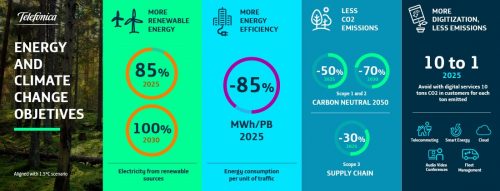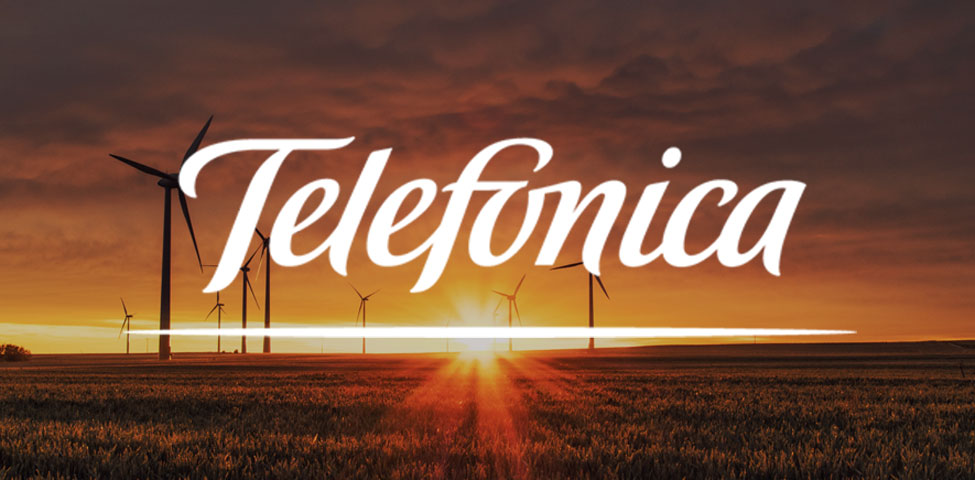Telefonica: Reducing Carbon Emissions
Telefónica has a strong strategy that integrates climate change and energy that is fully integrated in our business strategy. We are committed to reducing our own carbon footprint, but, secondly and more significantly, we offer digital products and services which reduce our customers’ emissions.
Given its global nature, climate change is currently integrated into the management of the core aspects of the company, such as governance, risks (implementing TCFD recommendations) and setting ambitious targets. Part of the variable remuneration of the Board and all employees are associated with achieving these targets.
This climate change and energy strategy is part of Telefonica’s Responsible Business Plan, headed by the Board of Directors. For over 10 years we have had a Global Energy Efficiency and Climate Change Office, comprising global areas like Operations, Environment and Procurement, in charge of implementing the strategy aligned with our core business.
As a result, we were included for the fifth year in a row in the climate change CDP A-list and achieved our 2020 targets (validated by SBTi) two years in advance, and have set new challenging energy and emissions targets, aligned with 1.5 degrees’ scenario.
These targets help us to leverage decarbonisation opportunities, to be more competitive and to offer our customers the cleanest network. We reduced our carbon emissions whilst reducing operating costs through efficiency and renewable energy.
Why it is important to MNO
Energy is an essential resource for the activity of telecom operators. Most of the energy consumption (95% in Telefónica) comes from operating our network, of which electricity consumption represents the majority (93% in Telefonica). So, energy efficiency and renewable sourcing are the key elements for reducing carbon emissions and at the same time, operating expenses, achieving a double win.
As a result of our integrated strategy, since 2015 we have been able to stabilise energy consumption (-0.29%, despite that the traffic managed by our networks increased by 176%) and at the same time, reduce our carbon emissions by 37%.

Figure 1: De-Carbonisation

Figure 2: Energy Consumption vs Traffic
On the other hand, decarbonisation demands not only maximum energy efficiency but also moving electricity consumption to renewable sources. Telefónica has a Renewable Energy Plan, through which 100% of our electricity in Europe, Brazil and 58% worldwide, comes from renewable sources (achieving our 2020 target, 50%, two years in advance).
In addition, switching to clean energy also reduces our operating expenses and makes us less dependent on fluctuations in fossil fuel prices. Our Renewable Energy plan projects a 6% savings on energy OPEX by 2020 and could reach 26% in 2030. The Plan includes all types of solutions: self-generation, renewable energy purchasing supported by certificates (guarantees of origin, iREC) and long-term agreements (Power Purchase Agreements – PPA) and non-conventional renewable energy takes priority.

Figure 3: Emissions avoided by using renewable energy

Figure 4: Renewable Electricity
Why is it unique
Telefonica’s integrated strategy has achieved great goals, both internally and externally.
In 2016, we set up 2020 targets, validated by SBTi:
- 30% reduction in carbon emissions (scope 1+2)
- 50% renewable electricity consumption
- 50% reduction in energy consumption per data traffic (MWh/PetaByte)
These targets were accomplished in 2018:
- -37% reduction in scope 1+2 emissions
- 58% renewable electricity consumption
- 64% reduction in energy consumption per data traffic.
So, during 2019, new and even more ambitious targets have been established for 2025/2030/2050, aligned with 1.5 degrees’ scenario:
- Halve emissions by 2020 (scope 1+2), 70% by 2030. Carbon neutrality by 2050
- 30% reduction in Scope 3 supply chain emissions in 2025
- 85% renewable electricity consumption. 100% by 2030
- 85% reduction in energy consumption per data traffic (MWh/PetaByte) by 2025
In addition, our digital services are a key means to reach emissions reductions in our customers’ activity.
Digitalisation and connectivity are the main instruments for dealing with the environmental challenges affecting society at large: climate change, water shortage, circular economy, pollution and loss of biodiversity. This new digital era is an opportunity for the process of transformation of the economy, business and society to be carried out while providing solutions to reduce the environmental impact. Many of our services now have this integrated approach.
Our business strategy is committed to the digital revolution, which is why we provide services based on connectivity, Internet of Things (IoT), Cloud or Big Data. In all of these we find environmental benefits; for example, with IoT services we make more efficient use of resources such as energy and water, with Big Data we are helping to improve traffic planning and air quality, and with drone-based services and connectivity, we can improve fire response.
Thanks to the IoT fleet management, energy building services, video/audio conferences, cloud and connectivity to promote teleworking, in 2018 we avoid the generation by our customers of 1.4 million tons of CO2. Our services avoided 1.2 times the emissions that we generated, that is, for each ton that Telefónica emits in its activity we are able to avoid 1.2 tons in our customers.
Our objective is to generate a greater positive impact: in 2025, for each ton of CO2 emitted by Telefónica, we will avoid 10 tons of CO2 into the atmosphere through our services.

For additional details about the case study, read here.
The GSM Association (“Association”) makes no representation, warranty or undertaking (express or implied) with respect to and does not accept any responsibility for, and hereby disclaims liability for the accuracy or completeness or timeliness of the information contained in this document.

